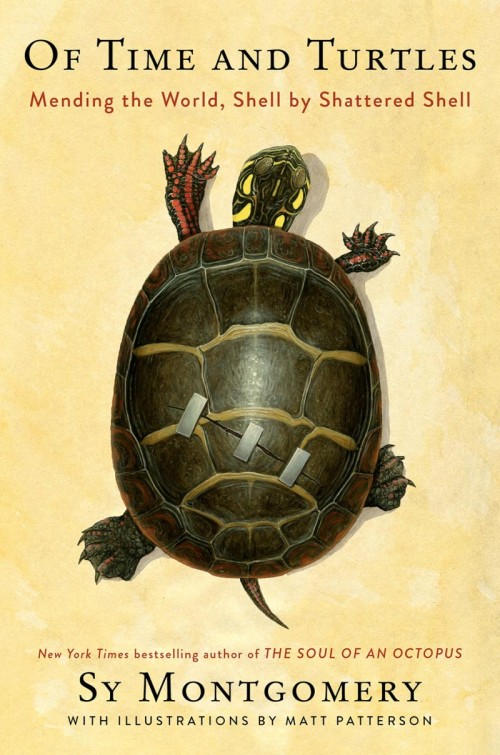by Sy Montgomery, with illustrations by Matt Patterson
Mariner Books, 2023
“Turtles are the most imperiled major group of animals on earth,” writes Sy Montgomery in her most recent book. “Like other wild animals, turtle populations shrink when houses, roads, and stores displace their homes.” Montgomery also notes that turtles face dangers from pollution to climate change, dogs and natural predators, and a “murderous, monstrous illegal trade in turtles – for their meat, for their eggs, for their shells and for pets.”
Of Time and Turtles: Mending the World, Shell by Shattered Shell is an engaging book, part narrative, part descriptive, that focuses on New England species. The book is illustrated by Matt Patterson, a frequent collaborator and Montgomery’s New Hampshire neighbor.
The book follows the trajectory of the author’s growing knowledge. Montgomery and Patterson volunteer at Turtle Rescue League in Massachusetts, founded by Alexxia Bell and Natasha Nowick. The facility can house and treat up to 150 injured turtles at a time. Some patients stay for months before they are fit enough for release; some become permanent residents.
Turtles are slow-moving creatures, but this does not connote a lack of intelligence. Rather, it is a lack of hurry. Montgomery tells us turtles make deep, mesmerizing eye contact. They come to appreciate their caregivers, nodding their heads in recognition and allowing the humans to pet their heads and their shells. According to Montgomery, even snappers may be safe to handle once the person and the turtle have become accustomed to each other.
Montgomery and Patterson especially admire Fire Chief, a 42-pound, 60-year-old snapping turtle. “After a truck ran him over, he flipped on his back, rolled down an embankment and fell into the fire pond where he normally spent his summers,” Montgomery writes. By the time the turtle rescuers arrived, “the entire fire department had turned out – concerned about, but also intimidated by their snapper friend.”
Although Fire Chief’s back legs work, they are no longer strong enough to lift the back half of his body. Because his rescuers cannot allow him to return to his original home near a busy highway, they have built a pond for him near Montgomery’s and Patterson’s homes.
Montgomery quotes Christopher Raxworthy, assistant curator of herpetology at The American Museum of Natural History in New York City, who says that turtles don’t die of old age. “If it weren’t for infection or injury, turtles might just live forever,” Raxworthy says.
Turtles “live slowly. They breathe slowly…turtles also die slowly,” Montgomery writes. The reptiles also heal slowly. Because of this, Bell and Nowick never pronounce a turtle dead, Montgomery says, “until rigor mortis sets in and/or they detect the smell of decomposition.”
Montgomery is a highly accomplished wordsmith with dozens of nature books to her credit. She does extensive research and interviews and always learns hands-on. Not all readers will appreciate the personal way that the author characterizes wildlife – for example, in this book, she refers to turtles as “friends” – but her approach is deliberate, challenging readers to acknowledge the sentience and individual personalities of other creatures.
Now in her 60s, Montgomery realizes how fleeting life can be. She writes extensively of human time and of turtle time. When they rescue one turtle, or a pregnant turtle, or one with eggs or babies, she and her cohorts recognize how many more decades the reptiles will exist on this planet.
“I felt a profound change the year I turned sixty,” writes Montgomery. “I felt myself ready to join a new phase of life...Who better than turtles – ancient, unhurried, long-lived beings revered as icons of serenity and presistence – to show me the path to wisdom, and how to make my peace with time?”


